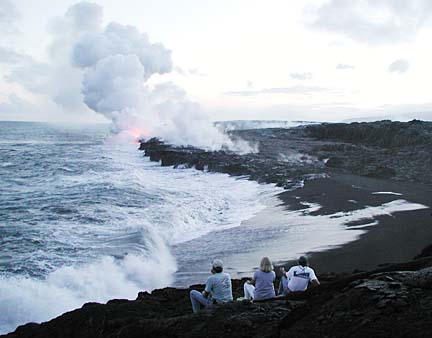


[ VOLCANO WATCH ] Pu'u 'O'o, Kilauea Volcano's active cinder-cone vent, has been undergoing abrupt yet steady changes over the past six weeks. Changes of Pu‘u ‘O‘o
vent steady but abruptERUPTION UPDATE
U.S. Geological Survey
Hawaiian Volcano ObservatoryThe ground surface subsided abruptly about six weeks ago, and gaping cracks opened around the edges of the subsidence zone, centered on the southwest edge of the cone.
A collapse pit about 100 feet in diameter and 50 feet deep nibbled into the cone's margin. A second collapse pit continues to deepen within the floor of Pu'u 'O'o's crater. One large rockslide and several smaller ones ensued.
Many of these structures likely formed within a short period of time, perhaps a few hours or a day. The timing is uncertain because our view of the site was often obscured by the fume cloud that emanates from Pu'u 'O'o. Once formed, however, the pits continued to enlarge for a few weeks.
These episodic collapses are slowly engulfing the cinder cone. Although not as dramatic as the collapse of January 1997, when the entire west flank disappeared overnight, these latest changes will ultimately carve a notch that breaches the southwest flank of the cinder cone, exposing the inner crater walls.
These collapse events typically occur without discharge of lava onto the ground at Pu'u 'O'o. Instead, the lava slips away in lava tubes, remaining invisible to our observations until seen at a skylight one mile away. With it, each day, goes a small part of the cone.
The strength of the lava layers beneath the cinders allows the ground to resist cave-ins and subsidence even as the foundation is plucked away.
The abrupt changes that we describe every few months may be precipitated by a drop or surge in the magma supply or by earthquakes, which jostle an already weakened Pu'u 'O'o. The constant subterranean erosion finally exceeds the endurance of rocks at the surface.
Continuous and episodic events characterize many geologic processes. The Pacific plate drifts northwestward continuously, but the islands grow in spurts. The building of an active volcanic island continuously loads the oceanic crust, but earthquakes occur sporadically as the forces overcome the strength of the rocks.
Remember the skyline presented by Pu'u 'O'o today, because it may be startlingly different in the future.
Eruptive activity of Kilauea Volcano continued unabated at the Pu'u 'O'o vent during the past week. Lava moves away from the vent toward the ocean in a network of tubes and descends Pulama pali in three separate areas. [ERUPTION UPDATE]
Tube break adds to flow
as vent keeps eruptingA breakout from the tube system above Pulama pali on July 9 fed a flow streaming down the pali and pooling in the coastal flats. This activity lasted for two days until the molten lava surface crusted over.
Small surface flows, primarily ooze-outs from inflated areas, are occasionally observed in the coastal flats. Lava continued to enter the ocean in the area east of Kupapa'u throughout the week.
The Star-Bulletin introduces "Volcano Watch," a weekly column written by scientists at the U.S. Geological Survey's Hawaiian Volcano Observatory. The writers will address the science and history of volcanos in Hawaii and elsewhere. It also will include a short, separate update on eruption activity on the Big Island. VOLCANO WATCH